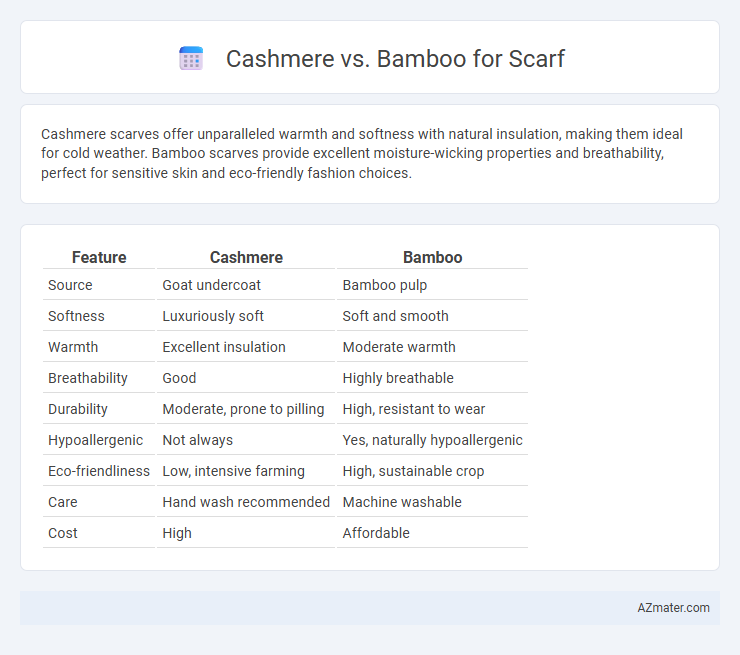Cashmere scarves offer unparalleled warmth and softness with natural insulation, making them ideal for cold weather. Bamboo scarves provide excellent moisture-wicking properties and breathability, perfect for sensitive skin and eco-friendly fashion choices.
Table of Comparison
| Feature | Cashmere | Bamboo |
|---|---|---|
| Source | Goat undercoat | Bamboo pulp |
| Softness | Luxuriously soft | Soft and smooth |
| Warmth | Excellent insulation | Moderate warmth |
| Breathability | Good | Highly breathable |
| Durability | Moderate, prone to pilling | High, resistant to wear |
| Hypoallergenic | Not always | Yes, naturally hypoallergenic |
| Eco-friendliness | Low, intensive farming | High, sustainable crop |
| Care | Hand wash recommended | Machine washable |
| Cost | High | Affordable |
Introduction to Cashmere and Bamboo Scarves
Cashmere scarves are crafted from the fine undercoat of cashmere goats, renowned for their exceptional softness, warmth, and lightweight feel, making them a luxurious choice for cold weather accessories. Bamboo scarves, derived from bamboo fiber, offer a sustainable alternative with natural antibacterial properties, breathability, and moisture-wicking capabilities. Both materials provide unique advantages, with cashmere excelling in insulation and plush texture, while bamboo scarves emphasize eco-friendliness and comfort in diverse climates.
Origins and Production Methods
Cashmere scarves originate from the undercoat of cashmere goats primarily found in Mongolia, China, and India, where fibers are hand-combed during the spring molting season to ensure softness and warmth. Bamboo scarves are derived from the cellulose of bamboo plants cultivated mainly in China, undergoing a chemical process called viscose or rayon production to transform raw bamboo into soft, breathable fabric. Both materials require meticulous production techniques, but cashmere's rarity and labor-intensive collection contribute to its luxury status, while bamboo offers a sustainable, eco-friendly alternative with natural antibacterial properties.
Texture and Softness Comparison
Cashmere scarves are renowned for their luxurious softness and fine, silky texture derived from the undercoat of cashmere goats, offering superior warmth and a lightweight feel. Bamboo scarves feature a smooth, silky texture with natural moisture-wicking and hypoallergenic properties, providing a soft, breathable alternative ideal for sensitive skin. While cashmere excels in plush softness and insulation, bamboo stands out for its eco-friendly production, silky texture, and temperature-regulating comfort.
Breathability and Temperature Regulation
Cashmere scarves offer excellent temperature regulation with natural insulation properties, keeping you warm in cold weather while remaining breathable enough to prevent overheating. Bamboo scarves excel in moisture-wicking and ventilation, providing superior breathability that keeps skin dry and cool in warmer conditions. Both materials balance comfort and temperature control, but cashmere suits colder climates and bamboo performs better in mild to warm environments.
Durability and Longevity
Cashmere scarves offer exceptional durability due to their dense, fine fibers that resist pilling and maintain softness over time, making them a long-lasting luxury option. Bamboo scarves, while naturally antibacterial and moisture-wicking, tend to be less durable as their fibers can weaken with frequent washing and wear. Choosing cashmere ensures sustained quality and longevity in scarves compared to the more delicate nature of bamboo fabric.
Allergen-Free and Hypoallergenic Properties
Cashmere scarves are naturally hypoallergenic due to the soft, fine wool fibers that rarely cause skin irritation, making them suitable for sensitive skin. Bamboo scarves offer excellent allergen-free qualities, containing natural antibacterial and antifungal agents that reduce the risk of allergies and skin reactions. Both materials provide breathable comfort, but bamboo stands out with its inherent moisture-wicking and hypoallergenic properties, ideal for allergy-prone individuals.
Eco-Friendliness and Sustainability
Cashmere scarves, derived from the soft undercoat of Cashmere goats, offer luxury but pose sustainability challenges due to overgrazing and high water consumption linked to goat farming. Bamboo scarves are eco-friendlier, as bamboo plants grow rapidly without pesticides and require less water, making them a renewable resource with lower environmental impact. Choosing bamboo supports sustainable textile production by reducing habitat destruction and promoting biodegradable, cruelty-free fabrics.
Style and Versatility
Cashmere scarves offer a luxurious texture and timeless elegance that effortlessly elevate any outfit, making them ideal for formal and casual settings alike. Bamboo scarves provide a lightweight, breathable fabric with natural moisture-wicking properties, perfect for versatile wear across seasons and active lifestyles. Both materials complement diverse wardrobe styles, but cashmere excels in warmth and sophistication, while bamboo shines in eco-friendly comfort and adaptability.
Price and Value for Money
Cashmere scarves typically command higher prices due to the labor-intensive production and rarity of fibers, often ranging from $100 to over $500. Bamboo scarves offer a budget-friendly alternative, usually priced between $20 and $50, while providing softness and moisture-wicking properties. For consumers prioritizing value for money, bamboo scarves deliver affordability and sustainability, whereas cashmere emphasizes luxury, warmth, and long-term durability.
Which Scarf Material is Right for You?
Cashmere scarves offer exceptional softness, warmth, and luxury, making them ideal for chilly climates and formal occasions, while bamboo scarves provide breathability, moisture-wicking properties, and eco-friendly benefits, perfect for sensitive skin and warmer weather. Choosing between cashmere and bamboo depends on your priorities for warmth, sustainability, and comfort--cashmere excels in insulation and plushness, whereas bamboo stands out for its hypoallergenic nature and environmental impact. Evaluate your lifestyle, climate, and skin sensitivity to determine whether the premium coziness of cashmere or the renewable, versatile quality of bamboo suits your needs best.

Infographic: Cashmere vs Bamboo for Scarf
 azmater.com
azmater.com